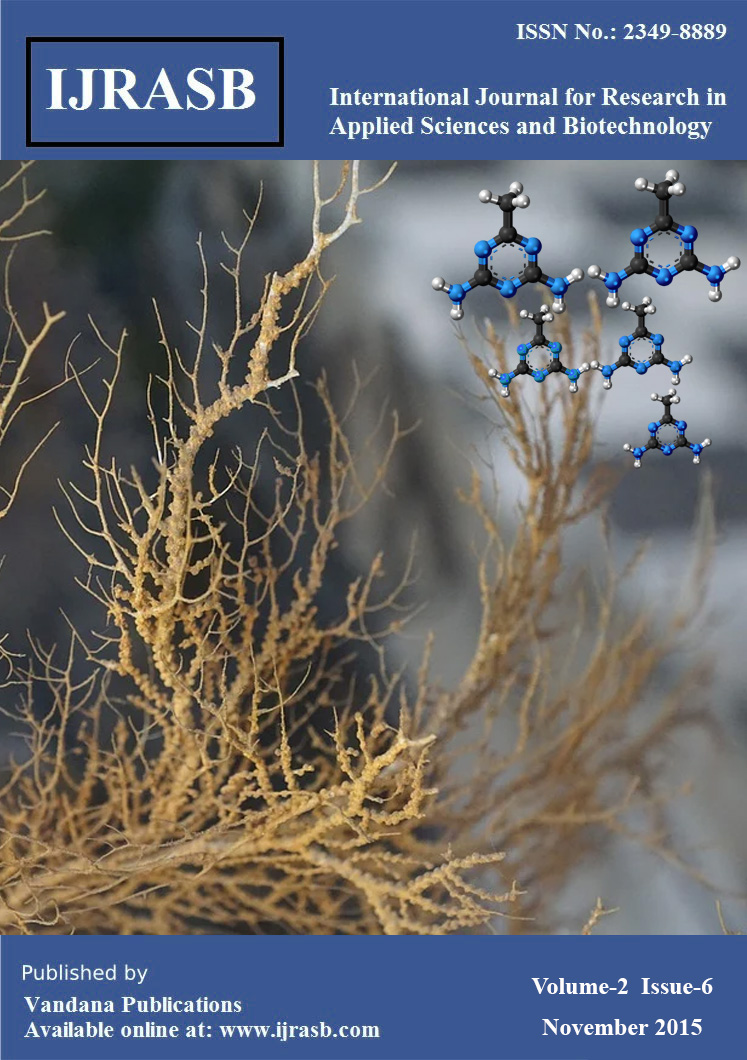Identifying Fusarium and Combinations in the Gibberella Fujikuroi Species Complex
Keywords:
Salt Gibberella Fujikuroi Complex, Translation Clongation Factor 1 α and β-tubulinAbstract
Mango malformation, caused by Fusarium mangiferae, represents the most important floral disease of mango. The first symptoms of this disease were noticed in the beginning of 2005 in plantations at Sohar in the Eastern U.P. of India. The affected inflorescences were abnormally enlarged and branched with heavy and dried-out panicles. Based on morphology and DNA-sequence data fir the genes encoding translation elongation factor 1 α and β-tubulin, the pathogen associated with these symptoms was identified as F. mangiferae.
Downloads
References
Altschul S. F., Gish W., Miller W., Myers E. W. and Lipman D. J., 1990. Basic local alignment search tool. Journal of Molecular Biology, 215:403-410.
Britz H., Steenkamp E. T., Coutinho T. A., Wingfield B. D., Marasas W. F. O. and Wingfield M. J., 2002. Two new species of Fusarium section Liseola associated with mango malformation. Mycologia,94:722-730.
Fisher N. L., Burgess L. W., Toussoun T. A. and Nelson P. E., 1982. Camation leaves as a substrate and for preserving cultures of Fusarium species. Phytopathology, 72:151-153.
Geiser D. M., Jimenez-Gasco M. M., Kang S., Makalowski I., Veeraraghavan N. and Ward T. J., et al. , 2004. FUSARIUM-ID v.1.0: A DNA sequence database for identifying Fusarium. European Journal of Plant Pathology, 110:473-479.
Geiser D. M., Lewis Ivey M. L., Hakiza G., Juba, J. H. and Miller S. A., 2005. Gibberella xylarioides (anamorph: Fusarium xylarioides), a causative agent of coffee wilt diaease in Africa, is a previously unrecognized member of the G. fujikuroi complex. Mycoligia, 97:191-201.
Guindon S. and Gascuel O., 2003. PHYML - A simple, fast and accurate algorithm to estimate large phylogenies by maximum likelihood. Systematic Biology, 52:696-704.
Hall T. A., 1999. BioEdit: a user-friendly biological sequence alignment editor and analysis program for Windows 95/98/NT. Nucleic Acids Symposium Series, 41:95-98.
Kumar J., Singh U. S. and Beniwal S. P. S., 1993. Mango malformation. One hundred years of research. Annual Review of Phytopathology, 31:217-232.
Marasas W. F. O., Ploetz R. C., Wingfield M. J., Wingfield B. D. and Steenkamp E. T., 2006. Mango malformation disease and the associated Fusarium species. Phytopathology, 96: 667-672.
Nirenbergm H. I. and O'Donnell K., 1998. Nwe usarium species and combinations within the Gibberella fujikuroi species complex. Mycologia, 90 :434-458.
Ploetz, R. C., 1994. Part III. Mango. In R. C. Ploetz, G. A. Zentyer, W. T. Nishijima, K. G. Rohrbach and H. D. Ohr (Eds.) Compendium of Tropical Fruit Diseases (pp. 36-37). St. Paul, MN, USA : American Pathological Society.
Ronquist F. and Heuelsenbeck J. P., 2003. MrBayes: bayesian phylogenetic inference under mixed models Bioinformatics, 19:1572-1574.
Steenkamp E. T., Britz H., Coutinho T. A., Wingfield B. D., Marasas W. F. O. and Wingfield M. J., 2000. Molecular characterization of Fusarium s u b g l u t i n a n s a s s o c i a t e d w i t h m a n g o malformation. Molecular Plant Pathology, 1:187-93.
Swofford D. L., 2003. PAUP*: Phylogenetic analysis using parsimony (*and other methods). Version 4b10. Sinauer Associates, Sunderland, Massachusetts.
Downloads
Published
How to Cite
Issue
Section
License

This work is licensed under a Creative Commons Attribution-NonCommercial-NoDerivatives 4.0 International License.








